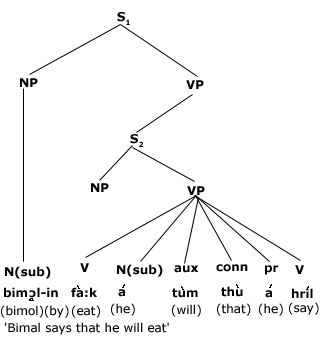carries
the sense of /hrìl/ and it shows only repetitive occurrence.
In case /hril/ is not used /ti/ could be shifted and
used in its place. It is also possible to split the
matrix clause and inset the embedded clause in between
the subject NP and VP of the matrix clause. |
 |
Thus
it appears that the clause ordering is very flexible
in Hmar. The embedded clause may follow or precede the
matrix clause or even split the matrix clause to inset
itself in it, but in most cases, the embedded clause
remains intact. |
|
In
many languages the infinitives verb phrase, in a sense,
is embedded in the matrix sentence. This is true of
Hmar also. Here the infinitives verb phrase is nothing
but the simple present tense verb form only and it occurs
just before the principal finite verb. Such a sentence
less the infinitives verb phrase is perfectly a meaningful
sentence. The following examples where the infinitives
verb phrase is put in the {....} could be seen: |
thí pù
ká {d pù
ká {d n}
nùom n}
nùom |
(tea)
(I) (drink) (like)
‘I like to drink tea’ |
hlá
á {sàk} nùom |
(song)
(she) (sing) (like) |
‘she
likes to sing a song’ |
|
à
hmú dí ìn
kán và fè tàh ìn
kán và fè tàh |
(hime)
(meat) (for) (we) (there) (go)+ past) |
‘we
went there to meet him’ |
| |
{sàhùon
én} dì ìn
à hú ìn
à hú tàh
tàh |
(zoo)
(see) (for) (he) (come)+ past)
|
‘he
came here to see zoo’ |
|
In
the first two examples the infinitives verb phrases
consist of one word each and they appear, in the surface
structure as well as deep structure, at the middle of
the matrix clause. But in the other two examples there
is a difference between surface structure and deep structure
realisations; although the infinitives verb phrases
look like appearing at the beginning of the clause,
they are in fact, in the deep structure realisation,
inset in the middle of the matrix clauses. |
| |
|
The
kernal sentences in Hmar, as in most other languages,
undergo various kinds of transformation in order to
generate negative, interrogative and passive sentences.
It may, however, be seen that the patterns of transformation
in this langauge, by and large, are simple and straight
forward. This is simple because the structure of verbs
in Hmar is very simple. It would be interesting to look
into various kinds of transformations in the context
of various kinds of verb structures. |